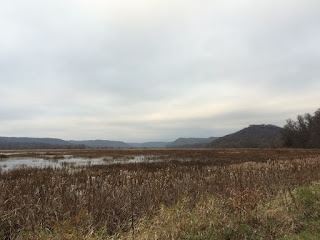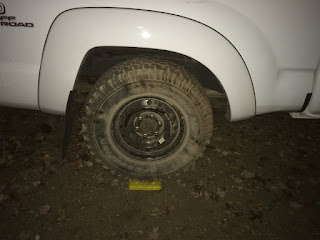The forecast was for two days of sun with temperatures in the 70s. For the first week of November, this was reason to jump in the truck for an impromptu trip- probably the last for the season. The fall leaves were in their final fading glory around the homestead and we had hopes of extending the fall color season a bit by heading south.
(You may click on photos for a larger version).
 |
| Serviceberry in our front yard. |
 |
| Fall is over when more leaves are on the ground than on trees. |
After completing some errands on Tuesday morning, we packed up the
camper and followed the Mississippi River south, stopping for lunch at
Frontenac State Park. The park was largely deserted on this beautiful
fall day. One of the perks of retirement is traveling during the week
when most people are hard at work.
 |
| PB&J for lunch. |
 |
| A view of the Mississippi from our lunch spot. |
We had selected the Whitewater River Valley as our destination. The
Whitewater River Valley runs through the driftless area of southeastern
Minnesota toward the Mississippi River- the same landscape as across the
Mississippi in Wisconsin, the scene of several recent trips. It is a
landscape of limestone bluffs, cold water streams and hardwood forests.
The valley is an object lesson in land use practices and conservation.
Native people had lived for thousands of years in the valley carved by
glacial runoff. They named the river for the color it turned as high
water in the spring eroded the light clay banks.
"When settlers arrived, they found a great diversity of plant life in the
Blufflands Landscape Region. In the valleys, they discovered a rich,
bottomland forest with clean, spring-fed streams teeming with native
brook trout. Oaks grew on some slopes with maple and basswood trees on
other slopes. South facing hillsides were covered with prairie. Much of
the uplands contained oak savanna, gently rolling prairie with scattered
oaks." -MN DNR
Following a treaty with the Dakota people in 1851, European settlers began to arrive and quickly set about clearing land for grazing and farming. Small towns quickly sprang up along the river- Beaver, Whitewater Falls, Elba. Farmers cleared forested hillsides and extended their fields and pastures up the steep slopes. Heavy rains, which in earlier times had been soaked up by the forests, now washed soil from the slopes and into the river. By the early 1900s, flooding became a major problem. The exposed sandstone eroded and covered the land with sand (more info and pictures
here). Eventually by the 1930s, repeated flooding had devastated the area and many farms and towns were abandoned. You can read about one such town
here. In less than a hundred years, an idyllic valley thousands of years in the making was decimated.
Beginning in the 1940s, conservation practices were put in place to stop erosion. The 28,000 acre Whitewater Wildlife Management area was established and erosion-prone land was purchased by the state. Today the
Whitewater Watershed Project works to promote good land use practices. As a result, the valley is again beautiful and productive. The Whitewater River is a designated trout stream. But the challenge continues to keep it that way.
 |
| Whitewater Valley |
We reached the valley in the afternoon and discovered to our surprise and disappointment that recent strong winds and rain had stripped the fall leaves from the trees. The landscape was ready for winter- the dominant colors were greys and browns. Our hoped for fall color was nowhere to be seen and far less than at home. But no matter, the weather was beautiful and we would enjoy ourselves.
We checked in at Whitewater State Park. We selected a site in the so-called primitive lower campground, which we had all to ourselves. Our site was alongside the Whitewater River, and the sound of the river provided a nice background song for our camp. With the end of daylight savings time, the sun sets early- around 5 PM. We made dinner and ate in the dark. After dinner chores, we took Rocky for a walk and enjoyed the stars. We finished the evening with a nice campfire.
 |
| Our campsite at Whitewater State Park. |
 |
| The campground was not busy. |
Morning promised a beautiful warm fall day. We ate breakfast and planned to explore the valley. We had seen an intriguing landmark on the map and decided to make the 1.5 mile hike in to see it. The trail followed the route of an old stage coach road through the woods. I unfortunately forgot the phone in the truck so I took no pictures. We did not know what we would find at the end but it was a nice day for a walk in the woods. After a final bend in the trail, we arrived at the Marnach House. Hidden from view until the very end, it was a pleasant surprise. The house is listed on the National Register of Historic Places and has an interesting story. You can read more
here.
 |
| Marnach House (photo from the internet here) |
We spent some time sitting in the sun at the house before heading back to the truck. Our next hike was to try to find an old cemetery from the 1850s marked on the map. There were two trails marked on the map that were longer than we wanted to do. We selected another route that looked shorter but would require crossing the river. We gambled that we would find a way across. When we reached the river, we scouted for a crossing. There was a downed tree that could be a bridge. I found a tree branch that could work as a walking stick and tested out walking on the tree. It was solid. About 2/3 way across, the surprisingly strong current of the river had cut a channel under the tree that was too deep for my stick support. Not being willing to try to advance on the narrow tree without support, I carefully turned around. We ultimately opted not to risk a dunk in the cold water. We were stopped by the river but had an enjoyable walk anyway.
 |
| A last bit of fall color. |
 |
| The Whitewater River. |
 |
| A nice walk. |
 |
| Panorama of the valley floor. |
We decided to visit another nearby state park to have a picnic lunch.
Carley State Park
was donated to the state in 1948 by state senator James Carley in hopes
of preserving an impressive stand of native white pines. It is a small
park with some rustic camping (closed for the season) and a nice picnic
ground along the river. We had a nice lunch, again having a park all to
ourselves but for some deer taking refuge from the fall hunt. We
realized later that we took no pictures.
After lunch we returned to Whitewater State Park, enjoying the drive
through the agricultural landscape surrounding the valley. We stopped at
the visitor center and registered for another night in the campground.
While there we toured a small but nicely done exhibit with a wealth of
information on the Whitewater Valley.
With our campsite secured and the afternoon sun still warm, we opted
for another hike to nearby Chimney Rock. The trail took us steeply up a
limestone cliff to a nice overlook. The namesake Chimney Rock was bathed
in late afternoon sun. We took a different route down with a long,
winding, wooden staircase making the descent easy. The soft sandstone at
the bottom was evidently too much to pass up by modern-day
petroglyph/graffiti makers.
 |
| Chimney Rock |
 |
| Setting sun through a hole in the rock. |
 |
| View of the river below. |
 |
| Another view of Chimney Rock and the valley below. |
 |
| Modern day petroglyphs (or vandalism, depending on your viewpoint). |
 |
| Stating the obvious. |
 |
| Pleasant picnic grounds built by the CCC. |
 |
| Chilling in the parking lot after the hike up to Chimney Rock. |
Back at camp we made an early dinner while daylight waned. Another campfire held the darkness at bay until, pleasantly tired from all the days walking, we retired to our snug bed. The weather report promised rain and colder temps for the coming day and we would return home with one stop on the way.
 |
| The last of the season's tomatoes went in dinner. |
 |
| Camp cooking. |
|
|
As promised, the day dawned cloudy and threatening rain. We packed up and headed for our next stop in Wabasha, Minnesota. We enjoyed a tour through the valley back to the Mississippi River and our trip north.
 |
| Panorama of the Whitewater marshes. |
 |
| Another view of the marshes. |
Wabasha, Minnesota is the site of the
National Eagle Center, our planned stop. We arrived in time to have a nice breakfast at Stacey's Kitchen before heading over to the Eagle Center. The Center is located on the banks of the Mississippi River in downtown Wabasha. Wabasha is a favorite wintering site for eagles. The current from the confluence of two rivers, the Mississippi and the Chippewa River from Wisconsin, keeps the water open all winter, providing a food source for the eagles. When we arrived, the resident eagles were enjoying their outdoor weathering perches adjacent to the building and overlooking the riverwalk trail that passes by the building.
The Center is filled with interesting exhibits about eagles, eagle art and beautiful wall murals, one of which was being painted by the artist while we were there. There are live, captive eagles in residence, found injured in the wild and rehabilitated by the
Raptor Center at the University of Minnesota. These birds have injuries that preclude them from being released back to the wild, so they live on at the center as ambassadors for their species. During our visit there were three bald eagles and one golden eagle present.
The live eagle display area includes generous windows to the outside overlooking the river. While we were there, a wild eagle flew past the window, sending the resident eagles into a frenzy of vocalizing, flapping their wings and hopping up and down. The naturalists explained the behavior as territorial displays, expressing their displeasure at the incursion of another eagle into their space. Cool to see.
Our visit included a talk about eagles by one of the staff experts, including a visit from one of the eagles. They are majestic birds and we enjoyed our visit very much. After a couple of hours at the Center, we headed for home, another trip completed. With winter on the way, it will be some months before we head out in the camper again.
 |
| National Eagle Center. |
 |
| Eagle ambassador. |
 |
| An interesting presentation. |






























































































